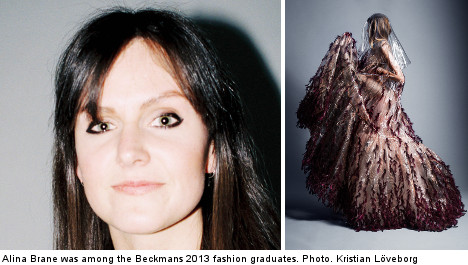Dreams featured heavily throughout the student’s designs. Reality came into question in synthetic fabrics, holographic drop piece dresses and sheer black bodices in Isabel Elfast’s Phantasm, while Alina Brane’s collection had more than just a little of Ophelia about it. Vulnerable maidens wore moulded plastic shrouds over their heads in colourful lace gowns, enveloped in further floor-length veils.
IN PICTURES: Looks from the Beckmans Fashion Graduate Show
There was a pleasing madness in Amandah Andersson’s printed silk gowns and jump suits in blue, red and apricot. The cut of the silk was elegant; the huge padded cocoons and pointy satanic masks were, well, nightmarish.
There were of course exceptions to the melancholic and sometimes scary day-dreaming. A welcome spurt of fun and frivolity hit the catwalk in Cassandra Yue’s 16 Forever. Teenagers dreaming of love in big red bows danced to a hip-pop beat. In a style resplendently akin to Meadham Kirchoff, big shiny bows play to a romance long forgotten, but were totally dressed for today.
A new romanticism perhaps? One that has evolved from the country’s heathen history and growing up close to nature, asked Göran Sundberg, Senior Lecturer in Fashion at Beckmans.
“A new romanticism [which] goes well in hand with the renewed interest in couture,” he said.
Lina Michel’s billowy sleeved gowns and jewelled petals in shades of forest berries epitomised the fusion of nature and design. An idea also represented in Fiffi Wilton’s ‘romantic melancholy’ with printed silk gowns and warm fleece the colour of pale winter skies and mud brown.
“Many of the stories are deeply personal,” said Sundberg. “I think this reflects the current development in fashion. Trends seem less all-embracing, and personal points of view become more relevant.”
As in Lamija Suljevic’s Like snow, white birds – a collection in memoriam to Srebrenica, a town ravaged by genocide in 1995. The Bosnian-born designer, who fled her worn-torn country aged five, showcased her signature weaves and focus on structure, this time in gold and virginal white. Gowns were either sheer or bejewelled with white plastic daisies. Virginal wedding gowns with an eerie sadness. The collection was poignant.
Other highlights included Emmy Andersson’s seamless sorbet layers and understated camel coats with only the finest of black lines as decoration. It just felt very now. Drop waist skirts covered in a mass of tiny ruffles and a dress that for one moment seemed to show a 3D flower but which then faded to print, were charmingly elegant.
Marianne Høst’s Charlotte Rampling inspired collection gave us slouchy linen, and a perfect backless dress in primrose yellow.
Femininity took an altogether different form in Ebba Camitz’ take on hip-hop. The designer stole beanies from the boys and presented voluminous dresses that were half 19th century bustle, half super-sized nineties American rapper.
Lisa Laurell Amadonico showed laser-cut leather in skeleton-like structures, an oversized monochrome coat, body-slick shifts and skin-tight pants. Both designers exploring in such distinct ways, the notion of the women in today’s society.
Beckmans has recently joined H&M in promoting sustainability in fashion, reusing clothes donated by the retail giant’s customers in the college student’s designs.
An intriguing and innovative idea, although I doubt very much that Per Götesson’s cannily real seaweed suit had a high-street past, mind you.
One could not help but raise a smile as Disney’s Little Mermaid tune Poor Unfortunate Souls bellowed out the speaker system to Götesson’s procession of pirates. Some wore the seaman’s obligatory cropped trouser (albeit in latex) cut to smithereens, others had webbed fishnet legs. It was mind boggling stuff.
Beckmans aims to encourage students to “express our identity and reflect the times in which we live”. I believe they did that here.
At times the collections reflected a melancholy ridden, pessimistic world, for which we have to grant the designers credit for their insight. But there was light and love too.
From bouncy loved-up teens to skeletal power women and destitute maidens – Beckman’s 2013’s collections are, above all else, testament that fashion as an extension of the designer’s innermost thoughts and ideas is by its very nature not always pretty, and sometimes extreme.
Victoria Hussey




 Please whitelist us to continue reading.
Please whitelist us to continue reading.
Member comments